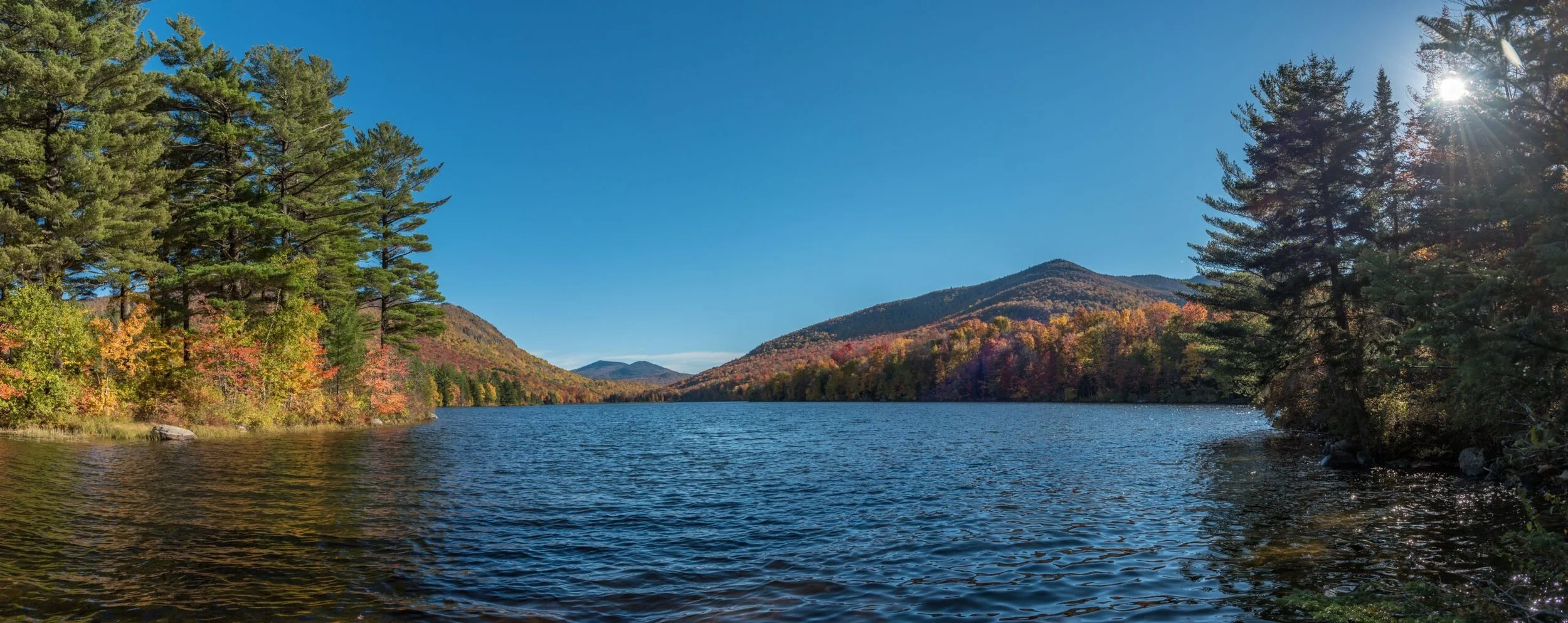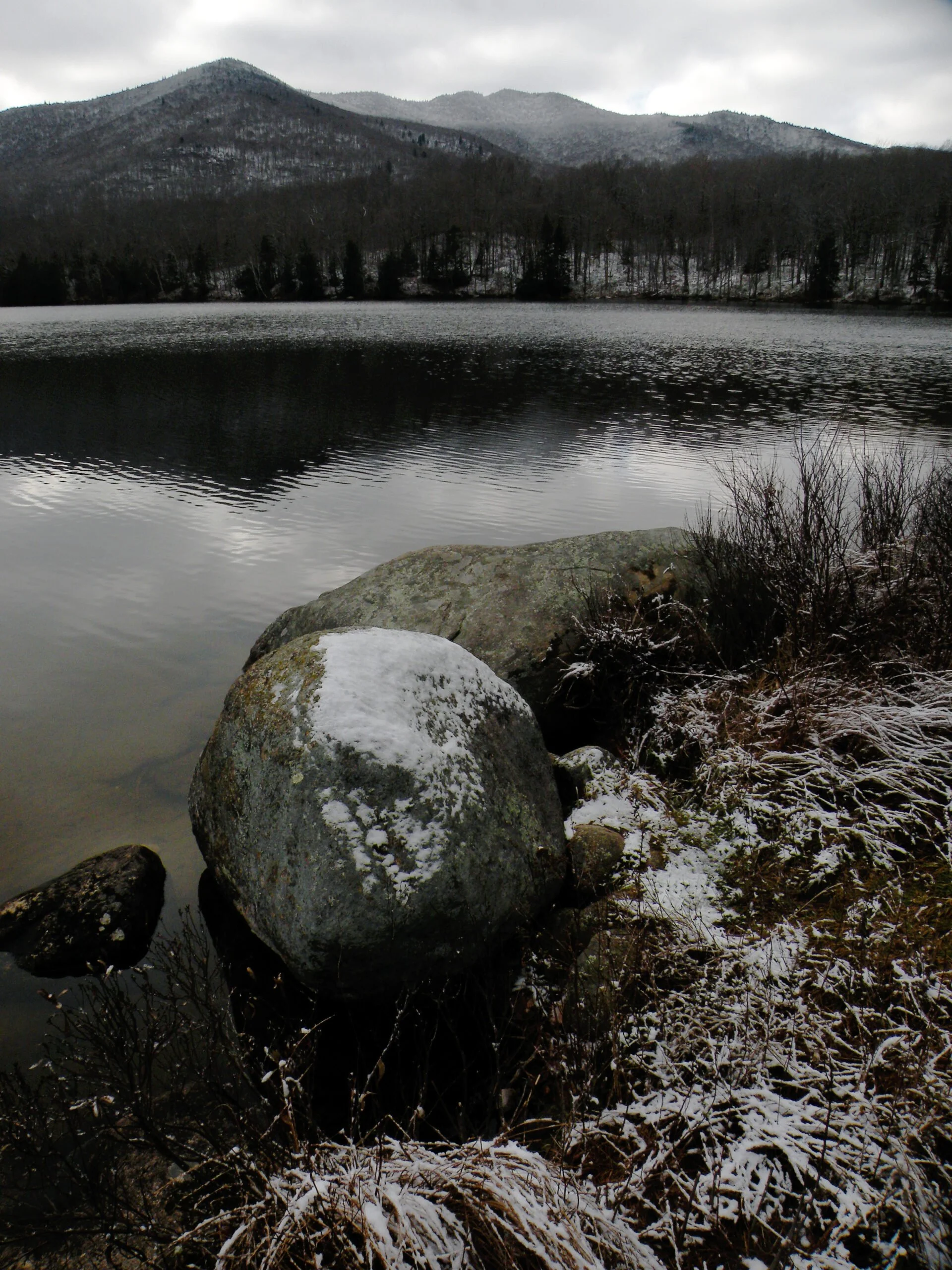Keep Debar Pond Un-Intense
As 2023 came to an end, we at Adirondack Wilderness Advocates were gearing up for what we expected to be a constitutional battle over the fate of a small lake in the far northern reaches of the Adirondack Park. “Keep Debar Pond Forever Wild” was to be our rallying cry, and we were planning ways to make an impact on what seemed to be building up to an inevitable statewide referendum.
The proposal on the table as recently as December 2023 was to take shoreline acreage out of the Forest Preserve for the sake of preserving a log structure constructed in 1940. In our view, any historical value Debar Lodge may possess was insufficient justification for amending Article XIV of the New York State constitution, and regardless of intent, this action would’ve frustrated public access to Debar Pond had it been approved.
In early January, I was in the process of drafting a memo of opposition—a document to be circulated among lawmakers in Albany—when I got word this task was no longer needed. Local officials in the Town of Duane, located in Franklin County, had just announced their own opposition, and this one action was enough to cause everyone to abandon the idea. If the local town board, representing the municipality in which Debar Pond is located, didn’t want a constitutional amendment to preserve the lodge, then no one was going to force one upon them.
The effort to preserve the lodge was therefore quietly withdrawn within days.
Obviously, if you agree with us that a wild pond should remain just that—forever wild—this was a very good outcome. However, the story wasn’t completely over: while the “Preserve Debar Lodge” effort was dead, New York State’s original plans were still on the books…
And this wasn’t such a hot idea either.
Previously at Debar Pond…
Like that hit TV show you’ve been streaming, it’s probably been a while since the last season, so you might need a refresher on the plot. What’s going on, and why should we care? So let’s back up a moment and make sure we’ve covered the basics.
Debar Pond is an attractive body of water located at the foot of its namesake Debar Mountain. It is not at all hard to reach, but it is so far out of the way for most Adirondack Park visitors that it is visited mainly by locals. Its mountainous neighborhood presents a fjord-like aspect, with a stunning view as you stand on the north shore looking south.
The entire pond falls within the Forest Preserve, and it is currently managed as part of the Debar Mountain Wild Forest. You can go there right now and explore it to your heart’s content, although there are few developed facilities other than a parking area. A gated road leads to the shoreline after a walk so short it can hardly be called a “hike.”
The controversy stems from the presence of a former camp complex on that northern shoreline—at the same spot offering the outstanding views. The buildings are now empty, and several are in poor condition, but the centerpiece is a sprawling log camp built in the “Great Camp” style.
Former Boundary Line at Debar Lodge
The proposal that AWA was prepared to speak against would have taken this camp complex out of the Forest Preserve for the sake of historical preservation. In this way, Debar Lodge was to be equated with Great Camp Sagamore, which was also acquired for the Forest Preserve in the 1980s but later withdrawn via constitutional amendment.
The question, though, was whether Debar’s historical value warranted such an extraordinary action. Whereas Sagamore represented a fundamental development in American architecture, and was later owned by someone famous by the name of Vanderbilt, Debar Lodge was a later imitation where nothing of any significance was known to occur. The proposed amendment assumed too much in my view: that the lodge could be sustained by a non-profit in perpetuity, and that the public had a desire to support any of the proposed uses. Despite the good intentions, there were no guardrails to prevent the lodge from becoming private real estate once again should the historical preservation effort fail.
The State’s Proposal
However, this was at least an earnest attempt to answer the question of what to do with the lodge. As a building standing on land in the forever-wild Forest Preserve, its legal status is tenuous, at best. Typically, any structure more substantial than a lean-to or fire tower is legally forbidden, and most are removed within a few years of purchase. This was the case with Nehasane Lodge on Lake Lila, for instance. I’ve already mentioned the parallels with Camp Sagamore, but Great Camp Santanoni is another precedent, where the historical significance of the structures was great enough to warrant an exception to policy.
Debar Lodge does not rise to the level of Santanoni, therefore getting everybody to agree to simply leave the buildings in situ is not an option—not if that means willfully ignoring more than a century’s worth of constitutional precedent. So if the policy can’t be changed, or if Article XIV can’t be amended, then the default requirement is to remove the buildings.
Doing so would restore the site to pure open space, a spot among the trees where anyone could visit without any buildings to impede the view. Just like any other body of water in the Forest Preserve.
And if this were the state’s plan for managing Debar Pond into the future, I would have no complaints. However, before the historical preservation amendment had been advanced, the Department of Environmental Conservation (DEC) had already been pondering the fate of the pond, and in 2020 it issued a draft management plan that envisioned a far different future.
Essentially, in DEC’s vision, the Debar Lodge site would become a developed picnic area. Yes, the lodge itself would be removed, but in its place would be a pair of picnic pavilions built in a style inspired by the rustic nature of the original structure. This facility would be serviced by twin parking areas and a restroom requiring installation of a septic system.
Debar Picnic Pavilion Proposals 2020
While such a proposal can hardly be considered “evil,” it is out of proportion to what the site would seem to require. Within this same region, there are already several developed DEC facilities that provide the same recreational options and more, therefore the need for a new picnic facility at Debar Pond is difficult to justify. DEC’s logic is that because buildings exist at Debar now, then something else should be built to replace them—as though allowing nature to simply be nature is the least palatable option.
Not a Foregone Conclusion
Unlike many state proposals, which sometime seem like foregone conclusions by the time the public hears about them, this development plan from 2020 is hardly shovel-ready. The main reason is because it was never approved; to become a reality, the picnic site would require a land reclassification by the Adirondack Park Agency (APA) from Wild Forest to Intensive Use, and the first step in that process is to craft a development plan to see where the new boundaries would need to be. This was as far as the proposal advanced, after being issued in 2020 during the height of the COVID pandemic.
Whether Debar Pond is turned into a historical preservation site or into a picnic facility, the bottom line is that no one seems to be seriously considering the possibility of managing the pond as a wild site. And wildness is always AWA’s preferred outcome. So there is still a need to take action; all that changes is our battle plan, since we’ll be encouraging public action against a state administrative action instead of voting in a public referendum.
If it were up to me, how would Debar Pond be managed? No different than West Canada Lake, or Round Lake, or the Essex Chain—places that are now Forest Preserve destinations but were historically associated with shoreline structures. In other words, the buildings currently standing at Debar would all be removed—or perhaps even relocated if feasible—and not replaced by anything manmade. Forever wild, pure and simple, with nothing more substantial than a universally-accessible path and a fishing dock.
Which by no means implies I think Debar Pond should be locked up and hidden from the general public. As a veteran guidebook author, I have a 25-year habit of viewing landscapes in terms of their recreational potential. So when you have a pond that can be reached by a 10-minute hike, and it is surrounded by mountains—one with a fire tower, the other with an array of rocky ledges—I envision a trailhead hub where people can take either a leisurely walk around the pond or engage in a more strenuous trek up one mountain or the other.
Debar Pond and Mountain
This is one point where DEC and I agree, as all of these features happen to be auxiliary ideas that were included in the 2020 proposal—and not one of them is dependent upon the construction of a picnic area. Trails and campsites and lean-tos are features appropriate to any Forest Preserve management area, and they have the benefit of not requiring any land reclassifications, constitutional amendments, or any other extraordinary action. The state would simply need to agree to a management plan and then act upon it.
Thus we will be taking action on Debar Pond in 2024 anyway, despite the abrupt change to our original plans. Although there is no public comment period currently open on any of the proposals I’ve discussed, AWA plans to proactively address the DEC’s 2020 proposal with a petition, asking the state to consider wilder options for the future of the pond—no lodge, no pavilions, no septic tanks, just pine trees framing that outstanding view.
So instead of “Keep Debar Pond Forever Wild,” the rallying cry needs to be reimagined. My vote is for “Keep Debar Un-Intense,” a reference to the Intensive Use reclassification that would be required to make the pavilions and septic tanks a reality. Debar Pond should not be intense—it should be a place to unwind, a place to connect with a wild landscape on its own terms.
Seriously, what else does the world need?
Banner photo: Debar Pond by Brendan Wiltse




